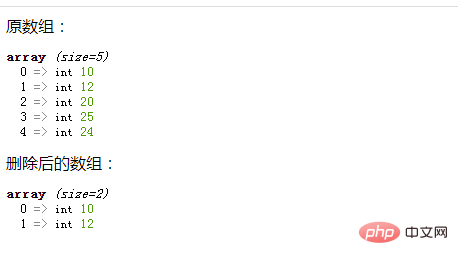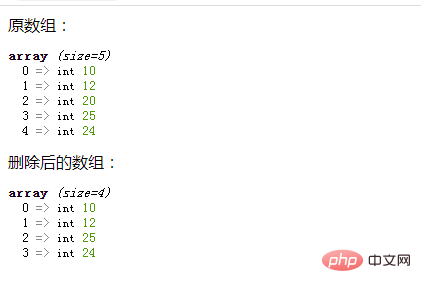PHP array learning how to remove any element
In the previous article, we introduced the method of deleting the first element or the last element in the array. If you are interested, you can click on the link to view → "PHP Array Learning: How to Remove the First and Last Elements 》. This time we continue to introduce deleting array elements and show you how to delete any element of the array.
Most of the time, the elements that need to be deleted are not fixed. They are not necessarily the beginning or end of the array, nor do they necessarily delete only one. This makes it impossible to use the array_shift() and array_pop() functions. So how can we delete any element in the array? Let’s find out today.
We previously introduced the array_splice() function in "PHP Array Learning Skillful Use of Functions to Insert Elements (2)". It is a powerful function with multiple functions: it can be inserted Array elements can be replaced, and of course array elements can be deleted (after all, the job of the array_splice() function is to delete the specified element and replace it with other values). Let’s take a look at its deletion function.
Let’s look at a small example below.
<?php
header("Content-type:text/html;charset=utf-8");
$arr=array(10,12,20,25,24);
echo "原数组:";
var_dump($arr);
echo "删除后的数组:" ;
array_splice($arr,2);
var_dump($arr);
?>The output result is:

It can be seen that we use array_splice($arr,2)from the $arr array Elements are deleted starting from the 3rd element, and a total of 3 elements are deleted (all elements starting from the 3rd element are deleted). array_splice($arr,$start) will delete all elements starting from the $start position.
The $start parameter has three values:
is a positive number, then start from the $start position and delete later;
## If - # is 0, then delete it starting from the first element; if
- is a negative number, then start from the position
-start from the end of $arr Start by deleting from the back to the front. For example -2 means start from the second to last element of the array.
<?php
header("Content-type:text/html;charset=utf-8");
$arr=array(10,12,20,25,24);
echo "原数组:";
var_dump($arr);
echo "删除后的数组:" ;
array_splice($arr,-2);
var_dump($arr);
?>
$length parameter (the third parameter) to the function, which is used to specify the number of elements to be deleted.
<?php
header("Content-type:text/html;charset=utf-8");
$arr=array(10,12,20,25,24);
echo "原数组:";
var_dump($arr);
echo "删除后的数组:" ;
array_splice($arr,2,1);
var_dump($arr);
?>
- is a positive number, then it means deleting length elements;
- is a negative number, then all elements starting from start and ending with length counting down from the end of the array will be deleted;
- If it is omitted, then all elements starting from start will be deleted. All elements up to the end of the array.
<?php
header("Content-type:text/html;charset=utf-8");
$arr=array(10,12,20,25,24);
echo "原数组:";
var_dump($arr);
echo "删除后的数组:" ;
array_splice($arr,2,-1);
var_dump($arr);
?>$lengthThe parameter can also be 0, which means no To delete an element, you can combine it with the fourth parameter $value of the function to perform an insertion operation (I will not give a detailed introduction here).
PHP function array array function video explanation, come and learn!
The above is the detailed content of PHP array learning how to remove any element. For more information, please follow other related articles on the PHP Chinese website!

Hot AI Tools

Undresser.AI Undress
AI-powered app for creating realistic nude photos

AI Clothes Remover
Online AI tool for removing clothes from photos.

Undress AI Tool
Undress images for free

Clothoff.io
AI clothes remover

AI Hentai Generator
Generate AI Hentai for free.

Hot Article

Hot Tools

Notepad++7.3.1
Easy-to-use and free code editor

SublimeText3 Chinese version
Chinese version, very easy to use

Zend Studio 13.0.1
Powerful PHP integrated development environment

Dreamweaver CS6
Visual web development tools

SublimeText3 Mac version
God-level code editing software (SublimeText3)

Hot Topics
 1359
1359
 52
52
 CakePHP Project Configuration
Sep 10, 2024 pm 05:25 PM
CakePHP Project Configuration
Sep 10, 2024 pm 05:25 PM
In this chapter, we will understand the Environment Variables, General Configuration, Database Configuration and Email Configuration in CakePHP.
 PHP 8.4 Installation and Upgrade guide for Ubuntu and Debian
Dec 24, 2024 pm 04:42 PM
PHP 8.4 Installation and Upgrade guide for Ubuntu and Debian
Dec 24, 2024 pm 04:42 PM
PHP 8.4 brings several new features, security improvements, and performance improvements with healthy amounts of feature deprecations and removals. This guide explains how to install PHP 8.4 or upgrade to PHP 8.4 on Ubuntu, Debian, or their derivati
 CakePHP Date and Time
Sep 10, 2024 pm 05:27 PM
CakePHP Date and Time
Sep 10, 2024 pm 05:27 PM
To work with date and time in cakephp4, we are going to make use of the available FrozenTime class.
 CakePHP Working with Database
Sep 10, 2024 pm 05:25 PM
CakePHP Working with Database
Sep 10, 2024 pm 05:25 PM
Working with database in CakePHP is very easy. We will understand the CRUD (Create, Read, Update, Delete) operations in this chapter.
 CakePHP File upload
Sep 10, 2024 pm 05:27 PM
CakePHP File upload
Sep 10, 2024 pm 05:27 PM
To work on file upload we are going to use the form helper. Here, is an example for file upload.
 CakePHP Routing
Sep 10, 2024 pm 05:25 PM
CakePHP Routing
Sep 10, 2024 pm 05:25 PM
In this chapter, we are going to learn the following topics related to routing ?
 Discuss CakePHP
Sep 10, 2024 pm 05:28 PM
Discuss CakePHP
Sep 10, 2024 pm 05:28 PM
CakePHP is an open-source framework for PHP. It is intended to make developing, deploying and maintaining applications much easier. CakePHP is based on a MVC-like architecture that is both powerful and easy to grasp. Models, Views, and Controllers gu
 CakePHP Creating Validators
Sep 10, 2024 pm 05:26 PM
CakePHP Creating Validators
Sep 10, 2024 pm 05:26 PM
Validator can be created by adding the following two lines in the controller.





